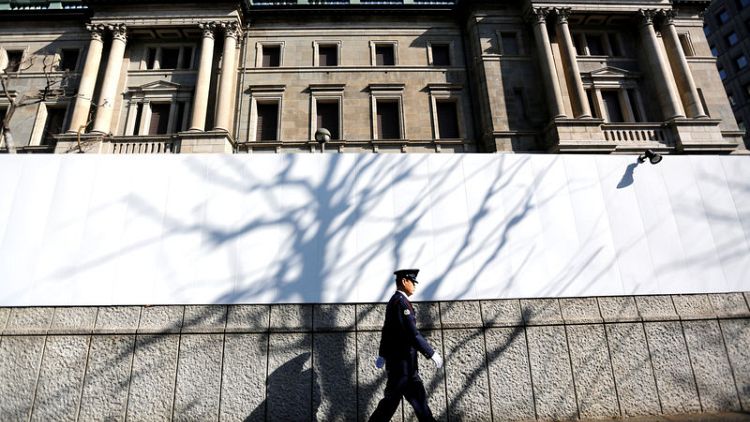By Leika Kihara
TOKYO (Reuters) - Bank of Japan officials are divided on whether to ease monetary policy next week or hold off, as they grapple with the need to protect the economy from an unwelcome yen spike and heightening global uncertainties with a dwindling tool-kit.
There is no consensus within the BOJ yet on the preferred move at the July 29-30 rate review, as much will depend on the European Central Bank's policy decision on Thursday and the market response, say sources familiar with the BOJ's thinking.
With robust domestic demand making up for weak Japanese exports, many BOJ officials see no imminent need to ramp up monetary support, and prefer to save its limited ammunition for when the economy faces bigger problems, the sources say.
But some officials worry that by standing pat at a time U.S. and European counterparts are seen cutting interest rates or signal doing so, the BOJ risks appearing less dovish and sparking a yen spike that would hurt Japan's exports, they say.
Many analysts predict the BOJ will settle for a modest tweak to its forward guidance - a pledge central banks make on future monetary policy moves - and commit to keeping rates ultra-low over a longer-term horizon.
NO DONE DEAL
The idea is among options debated internally within the BOJ and will be on the table next week, if the board sees the need to forestall risks to Japan's economy, the sources say.
But it is hardly a done deal as some in the BOJ worry that seeking to appease markets with a tinkering of wording could backfire and push up the yen, if it is seen as a sign of its desperation, they say.
"Pledging to keep rates low longer won't be that effective when markets already expect the BOJ to keep ultra-low rates for years," one source said. "Markets may interpret it as a sign the BOJ is running out of ammunition, which is not good."
Major central banks, including the U.S. Federal Reserve and the ECB, are cutting rates or shifting to a more dovish policy stance as simmering U.S.-China trade tensions hurt trade activity and global growth.
Under a policy dubbed yield curve control (YCC), the BOJ pledges to guide short-term rates at -0.1% and the 10-year bond yield around 0% to achieve its elusive 2% inflation target.
It introduced forward guidance on rates in July 2018 and modified this in April. The BOJ now pledges to keep current ultra-low rates at least until around the spring of 2020.
NO EASY CHOICE
The BOJ's rate review is sandwiched between that of the ECB and the Federal Open Market Committee meeting on July 30-31, when the Fed is seen cutting rates at least 25 basis points.
The BOJ may feel compelled to ease if the ECB's decision or other events jolt markets and trigger a sharp yen rise.
Strengthening forward guidance, such as by committing to keep ultra-low rates until global uncertainties dissipate, could be among options if the BOJ were to ease, the sources say.
If stronger action is required, the BOJ may deepen negative rates and accompany it with steps to ease the pain ultra-low rates inflict on financial institutions' margins, they say.
Among the BOJ's nine-member board, three reflationist-minded policymakers favour acting sooner rather than later to pre-empt heightening global economic risks. But at least three others see no immediate need to act, prefering to spend more time scrutinising when global growth may pick up, the sources say.
BOJ Governor Haruhiko Kuroda has said the bank won't hesitate to ease if the economy loses momentum to hit 2% inflation. But he has added the BOJ will weigh the merits and costs of any further easing in making a decision.
Acting now is no easy choice for the BOJ, which has far less ammunition than the Fed, with Japan's interest rates already negative and years of heavy buying drying up bond market liquidity.
The worst case scenario for the BOJ is to use precious ammunition to counter yen rises, only to see the move reversed by the Fed's action.
"We expect the BOJ to become a little bit more dovish next week by changing the forward guidance," said Masaaki Kanno, chief economist at Sony Financial Holdings.
"We don't think the BOJ will announce anything so radical, probably because it's a day ahead of the FOMC meeting. A key factor is dollar/yen."
(Reporting by Leika Kihara; Additional reporting by Daniel Leussink; Editing by Richard Borsuk)



